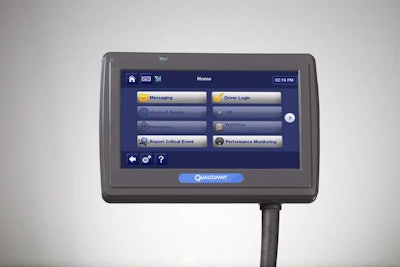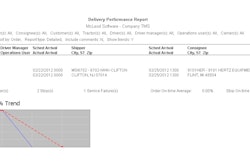
Ed Meyer, the director of transportation for H.T. Hackney Co., participated in a Qualcomm webinar on Wednesday, April 11, to share how he is using technology to improve fleet safety and efficiency.
H.T. Hackney is a privately owned, Knoxville, Tenn.-based company that operates 36 wholesale grocery warehouses from Grand Rapids to Miami, four furniture manufacturing and distributing facilities, and one water bottling facility. The company has a private fleet domiciled at each location with 700 total delivery vehicles.
In 2003, the company implemented Qualcomm’s Fleet Advisor onboard computing and mobile communications platform. The company recently made the decision to migrate to Qualcomm’s new MCP 50, which became commercially available on April 5. Installation has already begun.
H.T. Hackney has been using Qualcomm’s Hours-of-Service along with additional Qualcomm applications to monitor driver safety, productivity and route performance for a number of years.
“Image is the key. We wanted to make sure when we were out there, we were not doing things that gave our truck line a bad name,” Meyer says. “We wanted to make sure as we were growing that we maximize our efficiency and make sure we are protecting the general public.”
H.T. Hackney has created strict policies and enforcement methods for driver safety, particularly with regards to speeding. Its Qualcomm units are set up to monitor speed limits individually, by state. If drivers exceed the state limit, “we know,” he says.
Drivers are allowed three speeding events per year. A speeding event is automatically reported by Qualcomm when a driver exceeds the limit for more than 30 seconds. A driver is terminated for exceeding by 15 mph or more.
“We put this in place two years ago,” he says. “We’ve only had to let three drivers go because of it.”
To recoup its technology investment, H.T. Hackney is focusing heavily on reducing engine idling. The fleet’s idle time has dropped from 42 to 11 percent. The company also uses Qualcomm to monitor driver compliance to its idle policy: drivers are allowed 15 minutes of idle time per truck, per day, at startup. Trucks are not allowed to idle at customer locations or anywhere else unless a co-driver is in the bunk sleeping.
The use of electronic logs has all-but eliminated logbook infractions. With over 4,800 trips per month, H.T. Hackney has approximately 0.2 percent violations, but none are more than 10 minutes over the maximum 14-hours for on-duty time.
“Electronic logs are either your best friend or your worst enemy,” he says. “You just have to decide. For us it is our best friend. It doesn’t take me but a split second to find out if I have any violations for a specific period of time for the entire fleet. I don’t have to spread paper around. It’s all there electronically and it’s in real time. I love it.”











